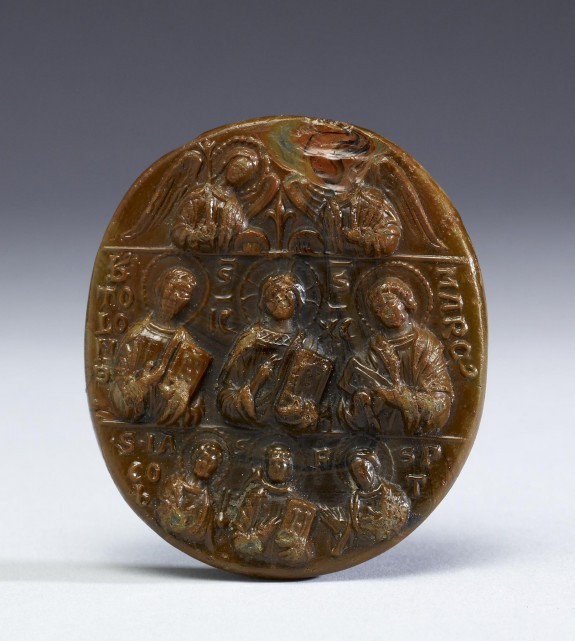Veneto : Pilgrim Medallion with Christ, Angels, Apostles and Saints

Pilgrim Medallion with Christ, Angels, Apostles and Saints
Glass medallion. 13th century, Venice Italy
2 5/8 x 2 5/16 x 7/16 in. (6.6 x 5.9 x 1.1 cm)
The Walters Art Museum, Baltimore MD
47.5
The Pilgrim Medallion with Christ, Angels, Apostles and Saints consists of a hierarchical configuration. Christ is located in the very middle with St. Bartholomew (1 of the 12 apostles) and St. Mark (patron saint of Venice whose body is housed in San Marco) to his left and right on the middle row. Below them are St. James (the brother of Christ), St. Francis (patron saint of Italy) and St. Peter (1 of 12 apostles). At the top of the coin are two angels.
This medallion or coin would have been presented to a pilgrim while visiting San Marco. Devotional tokens have long been rooted in Christianity with the purpose of reminding the holder of his or her faith in God, to offer a way of communication with God, and in general to strengthen one’s beliefs.
The practice of wearing amulets, pieces of metal or other material that were thought to ward off evil or diseases had originated as a Pagan practice and beginning between 300-700, the Holy Roman Empire sanctioned the allowance of devotional coins, which were stamped to commemorate people, such as Christ or the Virgin Mary, or Saints and even places such as shrines or churches and past historical events. These devotional coins were typically made of metal in the form of a coin and were not used as money.
A pilgrimage is a word used to describe a “holy wandering to sites of worship.” These sites are considered holy places because at a specific time, therewas a divine revelation that occurred. As time went on, pilgrimages became more widespread, the journeys became easier and safer and more people were going on pilgrimages out of curiosity and not just because of religious obligation. As a result, beginning in the 12th pilgrim tour guides started appearing in cities such as Rome and Venice. Also around that time the practice stamping lead or other metal devotional coins began being distributed at important pilgrimage sites. These pilgrim "souvenirs" were used not only as a stimulus to devotion but also to attest that a person had in fact reached their pilgrimage destination.
